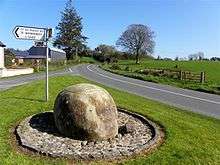Killycluggin

Killycluggin (from Irish: 'Coil a Chlogáin', meaning "the Wood of the Bell-Shaped Stone") is a townland in the civil parish of Templeport, County Cavan, Ireland. It lies in the Roman Catholic parish area of Templeport and the barony of Tullyhaw.
History
The first depiction of the townland of "Killycluggin" was on the 1609 Baronial Map[1][2] It was subsequently shown on the 1665 Down Survey map and also began featuring in their prints.[3]
Killycluggin is best known for the Killycluggin Stone, situated in a stone circle on Bannon's farm. Due to common belief that the stone's decorations represent Crom Cruach, a pre-Christian pagan god of Ireland, Killycluggin is known as the site where Crom Cruach became recognised. The stone became significant to the town on 23 June 1610 when The Plantation of Ulster along with King James VI and I decided to grant "Two polls of Kilclogen to Hugh Culme esquire, as part of the Manor of Calva." It was due to this motion that Clume surrendered his interest in Killycluggin to Walter Talbot of Ballyconnell. Talbot died on June 26, 1625 in Ballyconnell and his son, James Talbot, inherited the Killycluggin lands. He was ten years old at the time.
In 1635, James married Helen Calvert, the daughter of George Calvert, 1st Baron Baltimore. The couple had a son, George Talbot.
In the aftermath of the Irish Rebellion of 1641, James Talbot's estate in Ballyconnell was confiscated in the Cromwellian Act for the Settlement of Ireland 1652 because of Talbot's Catholic faith. He was later granted an estate in 1655 at Castle Rubey, County Roscommon as replacement. James died in 1687, upon which the lands at Killycluggin were divided between Dorby Don, John Reade, and Thomas Teddy.
James's son, George, went on to own an estate in Cecil County, Maryland. George named this estate Ballyconnell in honor of his native town in Cavan. George was later appointed surveyor-general of Maryland in 1683.
After the Cromwellian settlement, Killycluggin went to a man named John Blachford. Blachford was born in 1598 in Ashmore, Dorset, England. He was the son of Richard and Frances Blachford. Blachford became a merchant in Dorchester, Dorset, but fled to France in 1633 when facing a warrant from the Exchequer for not paying customs. Blachford married a woman named Mary Renald, from Devon. The couple had four sons, (John, Thomas, Ambrose, and William), as well as two daughters (Mary and Frances).
Blachford died in Lissanover, County Cavan in 1661. Despite his wishes to be buried in Dorchester, he was buried in St. Orvins, Dublin. Following his death, Blachford's will was published on 9 January 1665, leaving his son, John Blachford, as his sole heir. Following the publication, an inquisition was held in Cavan on 21 May 1667. This inquisition found that his widow, Mary Blachford as well as his son John were to be seized of, inter alia, the land of Killeclogine alias Killecragan.
Upon his father's death, Blachford's son William went on to become a Major. He dedicated a monument to his father before dying in Lissanover on 28 March 1727. The Blachford family gravestones are at St. Peter's Church in Parish Templeport.[4]
Books
The Tithe Applotment Books for 1827 list four tithe payers in the townland.[5]
Griffith's Valuation of 1857 lists sixteen landholders in the townland.[6]
In the 1901 census of Ireland, there were ten families listed in the townland,[7] and in the 1911 census of Ireland, there were only nine families listed in the townland.[8]
Antiquities
There are several chief structures of historical interest in the town and the land.
- A Neolithic Stone Circle (Site number 62 in Archaeological Inventory of County Cavan, Patrick O’Donovan, 1995) [9][10]
- A La Tène decorated standing stone called the Killycluggin Stone or the Crom Cruach Stone which was originally situated in the above stone circle but is now in Cavan County Museum (Site number 93 in Archaeological Inventory of County Cavan, Patrick O’Donovan, 1995) [11][12][13]
- A Bronze Age stone cist discovered when excavating the Killycluggin Stone (Site number 165 in Archaeological Inventory of County Cavan, Patrick O’Donovan, 1995) [11]
- A Megalithic Tomb (Site number 46 in Archaeological Inventory of County Cavan, Patrick O’Donovan, 1995)
- Two earthen ring-forts (Site numbers 774 and 775 in Archaeological Inventory of County Cavan, Patrick O’Donovan, 1995)
- An underground Souterrain discovered in ring-fort No. 774 above (Site number 1244 in Archaeological Inventory of County Cavan, Patrick O’Donovan, 1995)
- A Lime kiln
References
- ↑ "National Archives Dublin" (PDF).
- ↑ "Templeport Development Association - 1609 Baronial-Map".
- ↑ Trinity College Dublin: The Down Survey of Ireland.
- ↑ "Blachford Memorial detail". St Peter's Church Templeport. Retrieved 19 March 2017.
- ↑ , in the Tithe Applotment Books 1827
- ↑ "Griffith's Valuation".
- ↑ "National Archives: Census of Ireland 1911".
- ↑ "National Archives: Census of Ireland 1911".
- ↑ Antiquities of the Irish Countryside by Seán P. Ó Ríordáin (1979), p.55
- ↑ The Shell Guide to Ireland, by Lord Killanin, M.V. Duignan and Peter Harbison (Editor) (1989), p.61.
- 1 2 On a Stone with La Tène Decoration Recently Discovered in Co. Cavan, by R. A. S. Macalister, in The Journal of the Royal Society of Antiquaries of Ireland, Sixth Series, Vol. 12, No. 2 (Dec. 31, 1922), pp. 113-116.
- ↑ Excavations at Killycluggin, County Cavan by Barry Raftery, in Ulster Journal of Archaeology, Third Series, Vol. 41 (1978), pp. 49-54.
- ↑ Fragment of the Killycluggin Stone by Seán P. Ó Riordáin, in The Journal of the Royal Society of Antiquaries of Ireland, Vol. 82, No. 1 (1952), p. 68
Coordinates: 54°04′31″N 7°48′37″W / 54.07514°N 7.810271°W
